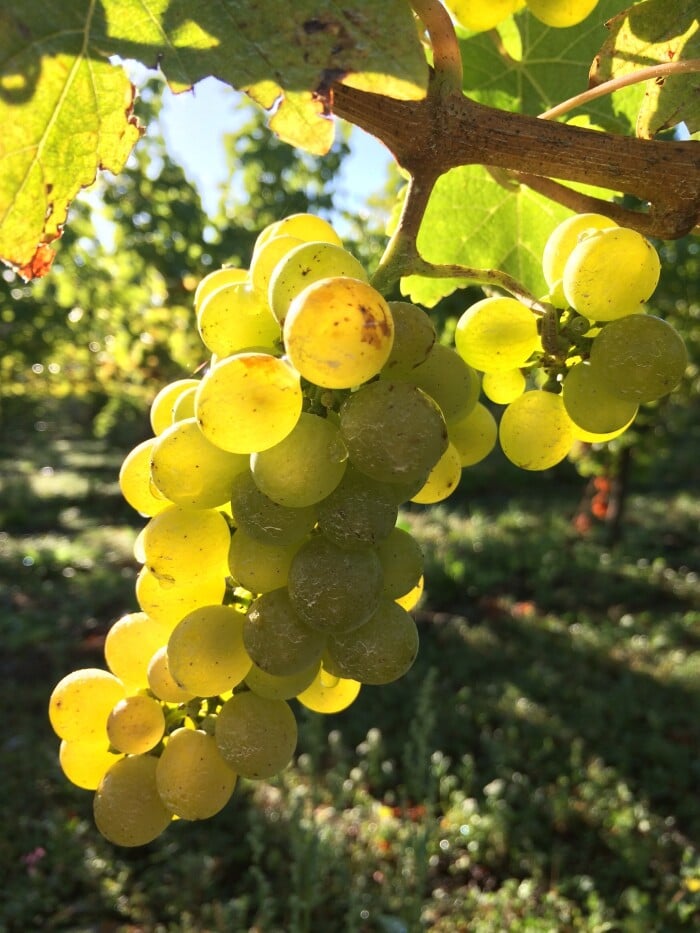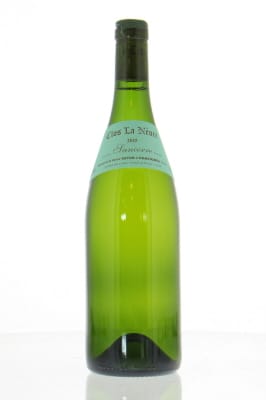
Sauvignon Blanc
The Sauvignon Blanc blanc produces wines with many faces, because there are only a few grape varieties in the world that offer such a wide range of flavours as Sauvignon Blanc. On the one hand, this white grape delights with green-grassy notes, while on the other, it can impress with an opulent exoticism.
The sauvignon blanc grape is also used for making sweet wines (including Sauternes).
Taste
Due to the acidity and aromas citrus fruit (grapefruit, lemon, green apple) and vegetable-like elements (asparage), as well as freshly cut grass, sauvignon blanc wines are refreshing. More mature sauvignon blanc sometimes develops a boxwood aroma, which is very characteristic. In warmer sauvignon blanc develops mainly tropical fruit elements.
Where does the Sauvignon Blanc grape variety come from?
Like so many grape varieties, Sauvignon Blanc also comes from France. For a long time, it was assumed that it originated in Bordeaux because it was first mentioned there under its name in 1710. However, recent analyses have shown that the grape actually comes from the Loire Valley. It was mentioned there as early as 1534 under the name ‘Fiers’. Incidentally, we have only been certain about this since 2013, when genetic studies revealed that Sauvignon Blanc is a natural cross between Savagnin Blanc and Chenin Blanc. The latter grape variety never occurred in Bordeaux, but it is one of the standard grapes in the Loire region. Sometimes you just have to use the process of elimination!
It is likely that monks brought Sauvignon Blanc to Bordeaux, where it is still one of the two main grape varieties for the region's white and sweet wines. A lot of Sauvignon Blanc is also grown in southwest France, but the two main French growing regions are and remain the Loire Valley and Bordeaux.
Sauvignon Blanc worldwide
From France, Sauvignon Blanc began its triumphal march around the world: at the end of the 18th century, the grape reached Chile and the United States, and later Australia, South Africa and New Zealand. Speaking of New Zealand: the island state played a key role in the modern success story of Sauvignon Blanc. The Marlborough region on the South Island became the centre of the New Zealand Sauvignon Blanc boom. The Cloudy Bay winery, founded in 1984, did pioneering work and ushered in the international breakthrough for New Zealand Sauvignon Blanc. The grape was initially met with great scepticism in Europe and the United States, simply because this exotic and highly intense world of aromas was previously unknown in the grape. Today, New Zealand is known worldwide as the ‘Sauvignon Blanc island’, with over 60% of the country's total vineyard area dedicated to this variety.
Another Sauvignon Blanc El Dorado is the Austrian region of Südsteiermark. Here, a very distinctive style of wine has been produced for many years. Sauvignon Blanc can also be found in almost all other wine-producing nations. Here, the style is usually not quite as independent, but always oscillates between France and New Zealand. This applies to Germany as well as to South Africa, Chile or the USA. A total of 140,000 hectares worldwide are planted with Sauvignon Blanc – and the trend is rising. The fact that more and more Sauvignon Blanc is being cultivated worldwide is mainly due to the different flavour profiles of the grape variety, all of which are very popular. Let's take a closer look.
What does Sauvignon Blanc taste like?
Sauvignon Blanc is known for its aromatic intensity and fresh acidity. The flavour profile varies depending on the climate, soil and vinification method, but can be categorised into two main styles. On the one hand, there is the green-grassy style, which is best known from the Loire region. Here, gooseberry, freshly cut grass and green bell pepper dominate the bouquet. On the other hand, there is the exotic New Zealand style with its fruity to tropical nuances. Exotic fruits such as passion fruit, pineapple or mango dominate – accompanied by lime, grapefruit and kiwi.
Incidentally, the fact that these two different styles exist has only a limited amount to do with climate and soil, but rather with the grape variety itself. This is because Sauvignon Blanc contains two different chemical compounds: methoxypyrazines and mercaptans. Methoxypyrazines are light-sensitive and disintegrate when exposed to sunlight, while the proportion of mercaptans increases as the berries ripen. However, they degrade rapidly when they come into direct contact with oxygen, as happens during the mechanical harvesting process. The management of the canopy (timing and intensity of leaf removal) and the harvest (mechanical or manual) directly influence the taste of the wine. This also applies to all stages of winemaking. Thanks to various pressing techniques, the effect of methoxypyrazines and mercaptans can easily be adjusted.
This also explains the existence of a third type of Sauvignon Blanc, which can be found in southern Styria, Austria, for example. Here, Sauvignon Blanc has a mineral character – and above all, it is very spicy. Hints of savoury or mustard seeds dominate the nose, along with mineral tones and a light vanilla note if the wine has been aged in barrels. The ideal drinking temperature for Sauvignon Blanc is between 8 and 12 °C. This temperature preserves the wine's freshness and highlights its vibrant aromas.
What are the ideal growing conditions for Sauvignon Blanc?
Sauvignon Blanc thrives best in cooler to temperate climates. The grape variety needs sufficient sunlight to fully develop its aromas. Depending on the desired style, however, winemakers also need to manage the canopy of leaves. This is because they can influence the aromas in one direction or another.
Well-drained soils – such as limestone soils in the Loire Valley – promote the minerality of the wine. On the other hand, high temperatures can lead to a loss of acidity and enhance unwanted aromas such as green bell pepper.
Which growing regions are known for Sauvignon Blanc?
We have already hinted at which countries produce unique Sauvignon Blanc wines. But now it's time to take a closer look at certain regions and appellations, so you can get a better idea of the different styles.
Loire Valley, France. In fact, Sauvignon Blanc is not grown everywhere along the Loire. The main focus is on the Centre Loire growing area. Here, two appellations in particular are making a name for themselves: Sancerre and Pouilly-Fumé. Both appellations produce intense Sauvignon Blancs that impress with pronounced mineral notes. The wines from Pouilly-Fumé also have an extraordinary flint note, which they owe to the silex soils.
Bordeaux, France. There is hardly a Bordeaux Blanc that does not contain Sauvignon Blanc – the same applies to Crémant de Bordeaux. In both cases, the fruity notes usually dominate, which clearly distinguishes the wines from their Loire counterparts in terms of taste. However, Sauvignon Blanc reaches true greatness in the sweet wines from Sauternes, which are considered true icons worldwide.
Marlborough, New Zealand. This is where the great Sauvignon Blanc classic of the New World comes from. You can recognise a Sauvignon Blanc from Marlborough immediately when you see it in the glass: exotic notes of mango, papaya, passion fruit, lychee and pineapple take the nose by storm, while the wine impresses on the palate with its great drinkability. This is the great taste contrast to the Loire wines.
Southern Styria, Austria. In the Alpine Republic, many things are different. This also applies to Sauvignon Blanc. The wines from here present themselves neither grassy-green nor exotically opulent, but shine with lots of spice and an unusual herbal depth. You have to like it. But then you will find yourself in a heaven of pleasure.
California, USA. In California, the name Fumé Blanc has proven that Sauvignon Blanc can also be aged very well and, above all, very intensely in wooden barrels. This gives the wine a unique smoky note, which was also the inspiration for the name.
Sauvignon Blanc and cuisine
Thanks to its freshness and lively acidity, Sauvignon Blanc is a very versatile food companion. Sushi and grilled fish in all variations, for example, go extremely well with a young Sauvignon Blanc. And that goes for all styles. Light pasta dishes with a lemon or herb sauce harmonise very well with a Sauvignon Blanc from the Loire or Bordeaux.
If you like cheese, we have another extra tip for you: try a goat's cheese with a Sancerre or Pouilly-Fumé (both Loire) – it's to die for! And a fruity Sauvignon Blanc goes very well with white asparagus or dishes with Jerusalem artichoke. As a general rule, the acidity of the wine balances out fatty dishes, while its aromas emphasise the freshness of many foods.
Three fun facts about Sauvignon Blanc
- Sometimes a Sauvignon Blanc can smell like cat urine. This is not a wine defect, but is due to a very high concentration of methoxypyrazines, which are responsible for the green-grassy notes in the wine.
- The name ‘Sauvignon’ is derived from the French word ‘sauvage’ (wild), because the grape variety originally grew as a wild vine. ‘Blanc’ means nothing other than ‘white’, which refers to the colour of the grapes.
- Bordeaux is the only wine region in the world where Sauvignon Blanc is routinely blended with Sémillon. In the rest of the world, Sauvignon Blanc is preferably vinified as a single variety.






